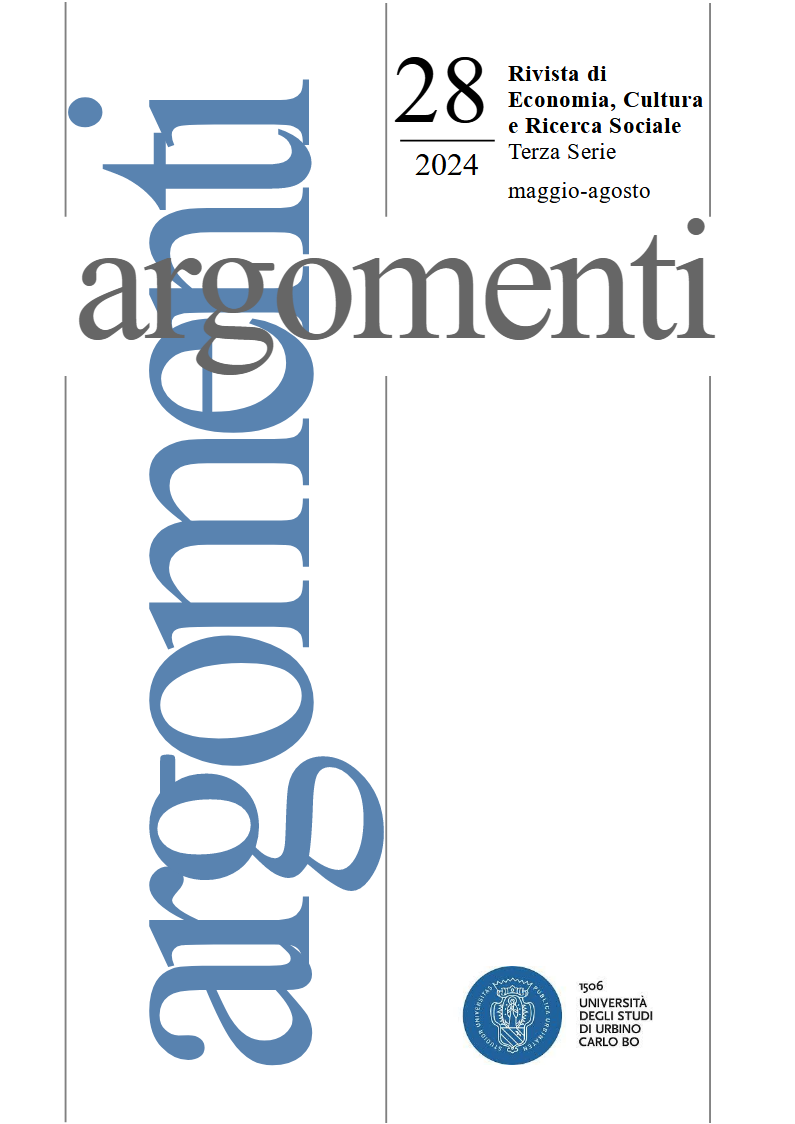Abstract
The population’s age structure, change, and future projections deserve attention regarding economic growth and public finance sustainability in European countries. A crucial issue for the decision-maker remains identifying the appropriate policy mix when allocating resources within the public budget. In this article, we analyze and discuss the effects of the ‘demographic winter’ on the economic system regarding GDP growth, public debt sustainability, and public spending composition, with particular attention to the ageing-related component. The main policies adopted in Italy to contrast the declining birth rate from a long-term perspective are discussed, and the private sector’s role is also considered to convert the winter into a demographic spring.
References
Alderotti, G. (2022). Female employment and first childbirth in Italy: what news?. Genus 78, 14.
Andrle, M., Hebous, S., Kangur, A. & Raissi, M. (2021). Italy: Toward a growth-friendly fiscal reform. Economia Politica, 38, 385-420.
Barbiellini Amidei, F., Gomellini, M., & Piselli, P. (2018). Il contributo della demografia alla crescita economica: duecento anni di “storia” italiana. Questioni di Economia e Finanza, Occasional paper n. 431. Banca d’Italia.
Beetsma, R., Klaassen, F., Romp, W. & van Maurik, R. (2020). What drives pension reforms in the OECD? Economic Policy, 35, 357-402.
Blanco-Moreno, Á., Urbanos-Garrido, R. M. & Thuissard-Vasallo, I. J. (2013). Public healthcare expenditure in Spain: measuring the impact of driving factors. Health Policy, 111(1), 34-42.
Blangiardo, G. C. (2024). The ‘demographic winter’ in Italy: Crisis factors, problematic issues and policy actions. European View, 23(1), 14-21.
Bordignon, M., Leonardo, C., Rosina, A. & Scutifero, N. (2023). Crisi demografica e sostenibilità del debito. Osservatorio Conti Pubblici Italiani.
Bonomi, E. (2022). La riforma dell’Assegno Unico Universale: cosa prevede e cosa si può migliorare. Percorsi di Secondo Welfare, 31 maggio 2022.
Chiacchio, F. & Tagliapietra, S. (2018). Italy’s pension spending: Implications of an ageing population. Bruegel blog post, 26 Aprile 2018.
Cattaneo, M.A. & Wolter, S.C. (2009). Are the elderly a threat to educational expenditures? European Journal of Political Economy, 25, 225-236.
Dalla Zuanna, G., Minello A., & Paolin, C. (2022). Work, couples, and fertility in Italy: back to Malthus? Working paper n. 09/01, Padua Research Archive.
De Philippis, M., Locatelli, A., Papini, G., & Torrini, R. (2022). La crescita dell'economia italiana e il divario Nord-Sud: trend storici e prospettive alla luce dei recenti scenari demografici. Questioni di Economia e Finanza, Occasional paper n. 683. Banca d’Italia.
Di Palo, C. (2019). Impact of population ageing on the Italian pension expenditure. Journal of Applied Economic Sciences, 14(4), 1203-1215.
Eurostat (2023). Population and population change statistics. Commissione Europea, Bruxelles.
Fantozzi, R., Gabriele, S. & Zanardi, A. (2023). Risorse per la sanità: dove colpirà l’inverno demografico. Lavoce.info, 22/12/2023.
Giacomobono, E. & Trentini, E. (2024). Otto grafici su fecondità e inverno demografico. Lavoce.info, 27/06/2024.
Gerdtham, U. G., Søgaard, J., Andersson, F., & Jönsson, B. (1992). An econometric analysis of health care expenditure: A cross-section study of the OECD countries. Journal of Health Economics, 11(1), 63-84.
Grob, U. & Wolter, S.C. (2007). Demographic change and public education spending: a conflict between young and old? Education Economics, 15, 277-292.
Il Sole24Ore. (2024) Nascite in calo: dalla Sardegna al Trentino-Alto Adige, ecco la classifica per numero medio di figli. 1 Aprile 2024.
Istat (2021). Previsioni della popolazione residente e delle famiglie | Base 1/1/2020. Istituto Nazionale di Statistica, Roma.
Istat (2023). Natalità e fecondità della popolazione residente. Anno 2022. Istituto Nazionale di Statistica, Roma.
Istat (2023). Previsioni della popolazione residente e delle famiglie | Base 1/1/2022. Istituto Nazionale di Statistica, Roma.
Istat (2024). Indicatori demografici. Anno 2023. Istituto Nazionale di Statistica, Roma.
Karami, S.J. (2017). The economics of dependency. How countries hit the demographic sweet spot. Foreign Affairs.
Kurban, H., Gallagher, R.M. & Persky, J.J. (2015). Demographic changes and education expenditures: A reinterpretation. Economics of Education Review, 45, 103-108.
Lopreite, M. & Mauro, M. (2017). The effects of population ageing on health care expenditure: a Bayesian VAR analysis using data from Italy. Health policy, 121(6), 663-674.
MEF (2023). Documento di Economia e Finanza 2023 (sezione I). Ministero dell’Economia e delle Finanze, Roma.
Minello A., & Cannito, M. (2023). Le equilibriste. La maternità in Italia. 2023. Save the Children Italia.
Ministero del Lavoro, della salute e delle politiche sociali (2009). La vita buona nella società attiva. Libro bianco sul futuro del modello sociale. Roma.
Modena, F. & Sabatini, F. (2012). I would if I could: precarious employment and childbearing intentions in Italy. Review of Economics of the Household, 10, 77–97.
OCSE (2021). Pensions at a glance 2021. OCSE, Paris publishing.
Openpolis (2024). Asili nido: obiettivo 33% a 5 punti, ma restano indietro sud e aree interne. Openpolis, 16 gennaio 2024.
Pearson, M., Smith, S. & White, S. (1989). Demographic influences on public spending. Fiscal Studies 10, 48-65.
Persson, T. & Tabellini, G. (2002). Political economics: explaining economic policy. MIT press.
Poterba, J. M. (1997). Demographic structure and the political economy of public education. Journal of Policy Analysis and Management, 16(1), 48-66.
Razin, A., Sadka, E. & Swagel, P. (2002). The aging population and the size of the welfare state. Journal of Political Economy, 110(4), 900-918.
RGS (2023). Le tendenze di medio-lungo periodo del sistema pensionistico e socio-sanitario – Rapporto n. 24. Nota di aggiornamento. Ragioneria Generale dello Stato, Ministero dell’Economia e delle Finanze, Roma.
Romp, W. & Beetsma, R. (2023). OECD pension reform: The role of demographic trends and the business cycle. European Journal of Political Economy, 77, 102280.
Servizio studi della Camera dei deputati (2023). L’occupazione femminile. Le Politiche pubbliche italiane n. 4 dicembre 2023. Dipartimento Lavoro, Camera dei deputati, Roma.
Yun, W.S. & Yuso, R. (2019). Determinants of public education expenditure: A review. Southeast Asian Journal of Economics, 7, 127-142.

This work is licensed under a Creative Commons Attribution 4.0 International License.
Copyright (c) 2024 Maddalena Bigini, Agnese Sacchi





